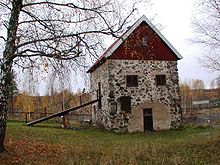- Dannemora mine
-
The Dannemora mine at Dannemora, Sweden was one of the most important iron ore mines in Sweden. The mine was closed by its owners SSAB in 1992. It may have been open since the 13th century, but the first documentary reference was in 1481. The mine supplied all the ironworks making oregrounds iron by the Walloon process (using a blast furnace and finery forge), such as Österby and Leufsta (now Lövsta). Their products were particularly pure iron, due the manganese content of the iron ore. This made it the best material for conversion to blister steel, the main variety of steel made in Great Britain between the 1610s and the 1850s. The mine has a depth of 640 metres.
History
Joachim Piper renewed the mining privileges at Dannemora in 1532 and devoted substantial resources to the mine, mainly producing iron but also other minerals. the ownership structure changed in 1545, and a dozen wealthy individuals entered as the owners, so that a number of Germans and even the king Gustav Vasa took part. The Germans were most interested in the export of pig iron but the King persuaded them to start production of wrought iron. It lasted only a few years and following a related bankruptcy, the king took over the operation fully.
Under 17th century. Dannemora iron had an uncontestedly high status among Swedish iron localities, especially in England where it was used in the steel raw material for tools, weapons, springs and other special purposes. A large part went to Sheffield. Thus Dannemora contributed to Sheffield's worldwide reputation as a steel city.
Around 1700 there were about sixty workers at Dannemora residents of the slum-like neighbourhoods around the mine. The number of workers who obtained their support from the mine is likely to be several hundred. In each mine large quantities of wood would used in mining, a method not abandoned until the 1730s. The reason for this was partly out of fear that gunpowder would be more expensive than wood, but also for danger's sake.
Throughout the mine's history, it had problems with water being situated by a lake. A pile-dam was built during the 17th century, and water- and wind-powered pumps were used. In 1728, at the initiative of Mårten Triewald, a steam-driven pump was installed, a Newcomen engine, the first in Sweden, but it was never a success. The failure was probably due to technology, which worked flawlessly in England, but was new to Sweden and was run by inexperienced staff. During the 1750s, it blew away two weirs and this destroyed a blast furnace, a mill and two sawmills. Despite a newly built dam, the mines were flooded in the spring flood of 1795 and it took until 1815 before the situation became normal. in 1805 a new steam engine of 10 horsepower was installed.
During the century 1770-1870, production was between 15,000 and 20,000 tonnes. In the 1870s, it rose to 40,000 tonnes and exports of pig iron from the Österby ironworks became significant. In order to facilitate shipments of ore Dannemora Hargs Railway was built in 1878. During the 20th century, production was 50,000 tonnes, but a strike in 1927 stopped its operation entirely. Only in 1935 was it resumed. 1955 a new facility, with sorting plant and concentrator was finished and the annual production reached 600,000 tons. During the latter part of the 1970s, output decreased but still amounted to about one million tonnes of crude ore, of which the bulk was exported.
Shareholders of Dannemora mines had declined since the late 19th century through closures and mergers. In 1937 the four remaining owners (Fagersta Bruk, Iggesunds Bruk, Hargs Bruk and Stora Kopparbergs Berglag) formed AB Dannemora Mines. In 1974 Stora Kopparberg became the sole owner of the Dannemora mine. During the crisis that hit the Swedish steel industry in the late 1970s, however, that the state SSAB was forced to take over the mine only four years later.
The Contemporary position
In 2008, preparations began to resume mining of iron ore as well as other more precious metals. The mine would be emptied of water and some estimated to be operating in full swing in 2009. The current owner is Dannemora Mineral AB, which was listed May 25, 2007. The initial stock placement was heavily oversubscribed.
References
This article is based mainly on the Swedish Wikipedia article, whose sources as given as:
- B. Boethius: Gruvornas, hyttornas och hamnarnas folk (1951)
- J. O. Carlberg: Historiskt sammandrag om svenska bergverkens uppkomst och utveckling (1879)
- Svante Lindqvist: The impact of the Introduction of Steam Engine Technology on the Society of Dannemora Mines (in Svensson, Nils Eric, Strandh, Sigvard: Tekniska Museet Symposium on the History of Technology, No. 1 (1977)
Also:
- K. C. Barrclough, 'Swedish iron and Sheffield steel' History of Technology 12 (1990), 1-39 - originally published in Swedish in A Attman et al., Forsmark och vallonjärnet [Forsmark and Walloon iron] (Sweden 1987)
Categories:- Iron mines in Sweden
- Former mines
- Uppland
Wikimedia Foundation. 2010.



